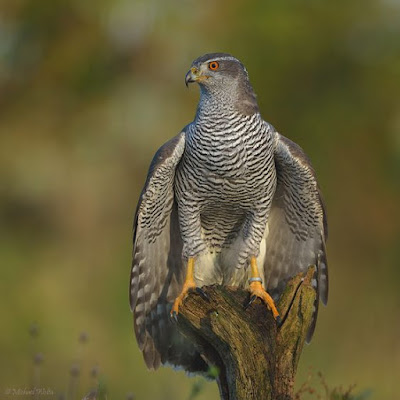A large and powerful bird of prey, the northern goshawk was
traditionally revered as a symbol of strength. It possesses short, robust wings
that enable rapid acceleration, and a long tail, which provides excellent
maneuverability while flying between trees. The adult plumage is brownish-grey
to slate grey above, with a black cap on the head and a distinctive white
stripe above the reddish-orange eyes. The underparts are light grey with fine
horizontal barring on the breast, and small, black, vertical streaks on the
throat. The adult female is considerably larger than the male, with browner
upper parts and coarser markings on the breast, while the juvenile is brown
above and pale buff to whitish below, with heavy streaking. The northern
goshawk exhibits a high degree of geographical variation, with eight subspecies
currently recognized, separated by size, coloration and plumage patterning.
Identification
Adult goshawks have black crowns, white eyebrows, and red
irises. As adults, Northern Goshawks are gray above and light gray with black
horizontal bars and vertical streaks below. Their tails have a series of
alternating dark-gray and light-gray bands. Females typically are larger,
browner, and have more heavily marked underparts. Juveniles have brown heads,
orange irises, and less distinct, whitish eyebrows. From above, juveniles are
brown with a fair amount of white mottling. From below, their cream-colored
underparts are heavily streaked with brown. The tails of juveniles have a
series of wavy, alternating dark-brown and light-brown bands with thin white
borders.
Like other Accipiters, the goshawk’s typical flight pattern
consists of a series of quick wing beats interspersed with brief bouts of
gliding. Compared to the two smaller North American Accipiters, the flight of
Northern Goshawks is more direct, and the flapping is slower with deeper wing
beats.
Behavior
Most goshawk populations are sedentary and they typically
remain in their nesting areas throughout their lives. Only goshawks that breed
in the north and northwestern parts of North America are migratory. They fly
south during the winter months and then return to their nesting areas in the
spring.
Northern goshawks are highly territorial and a mating pair
will advertise their nesting territory by performing an elaborate aerial
display before and during nest construction and/or repair. If their nesting
area is encroached upon, they will defend it fiercely. Northern goshawks live
alone or in pairs and are diurnal.
Food
Northern Goshawks eat a wider range of prey than other
accipiters, including birds, mammals, and reptiles, as well as insects and
occasionally carrion. Tree and ground squirrels, snowshoe hares, jackrabbits,
and cottontails are the main mammal prey. Goshawks also eat large birds such as
Dusky, Sooty, Spruce, and Ruffed Grouse, along with Pileated, Black-backed,
Three-toed, and Hairy Woodpeckers, Northern Flickers, Williamson’s Sapsuckers,
and corvids including Blue Jays, Gray Jays, Steller’s Jays, and crows. Look for
piles of feathers on the forest floor that may indicate a low “plucking perch”
near a goshawk nest.
Diet
The northern goshawk perches in trees and waits for prey
like birds, rabbits, hares, and squirrels. It drops down on prey on the ground.
It also chases birds through the forest and uses its tail to help maneuver
through the trees. It may chase prey for up to 30 minutes! The northern goshawk
also hunts in open fields. It takes its catch back to a perch and eats it.
Color Pattern
Adult goshawks are dark slate gray above with pale gray
barred underparts. They have a dark head with a wide white stripe over the eye;
the eye is orange to red. Immatures are brown and streaky, with narrow dark
bands in the tail. They have an indistinct pale eyebrow stripe and yellow eyes.
Females are larger than males.
Nesting
May mate for life. In display over nesting territory, adult
glides and circles, often with fluffy white feathers under tail spread out to
sides; also may do a series of shallow dives and upward flights. Male provides
most or all food for female, beginning before eggs are laid. Nest site is in
tree, often in deciduous tree in mixed forest, at a major crotch in the trunk.
Height varies, commonly 25-50' above ground, sometimes 15-75' up. Nest (built
mostly by female) is platform of sticks, lined with finer material, including
green foliage. Nest may be reused, with more material added each year, becoming
quite large.
Status/Protection
The Northern Goshawk was affected by important declines in
Europe in the 19th and 20th centuries, due to persecution and deforestation.
Later, other declines occurred with poisoning from pesticides and heavy metals.
This species is still threatened by persecution and nest
robbing for falconry. The wind farms’ development is an important threat for
them too. However, the Northern Goshawk has wide range and its populations are
now fairly stable. The global population was estimated at 500,000 individuals
in 2004. The Northern Goshawk is currently evaluated as Least Concern.




















No comments:
Post a Comment